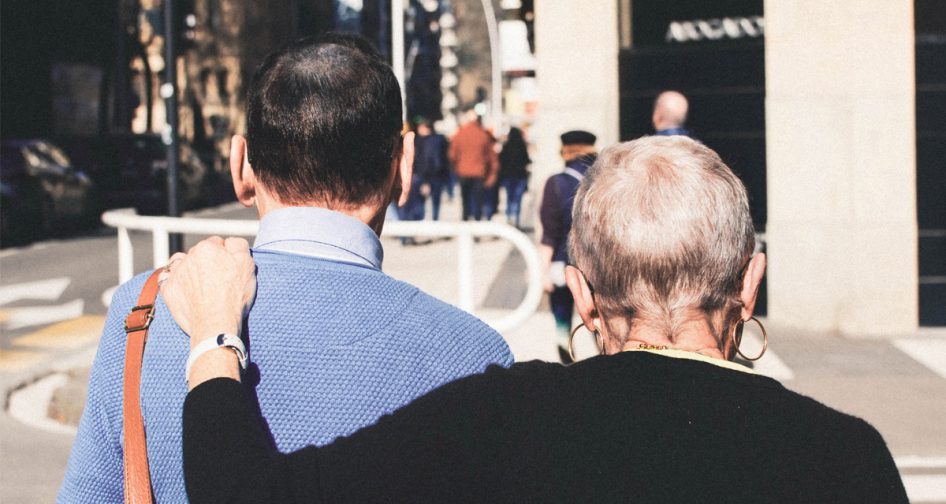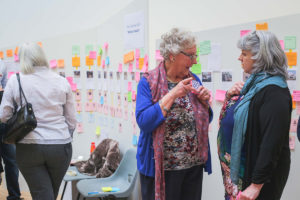How design can help when you have limited travel options.
In 2012, Ethel’s eyesight had deteriorated so much that both her doctor and son had urged her to stop driving because it was becoming unsafe. Consequently, Ethel and her son were concerned for her quality of life. He lived a 2 hour drive away so wouldn’t be readily available to help, and he wants her to be active. Furthermore, Ethel has friends on the other side of the city, and she wants to be able to connect to her community, with a level of independence.
Before working on Car Freedom and hearing about people like Ethel – I’d never considered the idea of ‘giving up the car’. This is because I come from a family that doesn’t really drive, but also I’m someone who has always lived in cities. I have relied on public transport, or my bike to get me from A to B – mostly without challenge.
Car Freedom, a vision from Dr Steve Cassidy, was developed in collaboration with Peter Ashe and Andy Hyde (who now work on some brilliant dementia travel projects). It was a design that was born out of a response to the growing calls about giving up the car – particularly for older people.

In 2012, there were 121 motorists over the age of 100 still holding a driver’s license (who are my total heroes!). However, press at the time highlighted concerns around older drivers and debates ensued on testing older drivers more often and banning them from major roads. It’s important to note that the data wasn’t conclusive about whether older drivers were unsafe or not. Yet, there was a large growing number of older people suddenly having to give up their cars, which was a concern.
Older people give up their cars due to medical reasons, lack of confidence, lack of financial resources and lack of opportunities to use the car. They often make the decision independently, or at the advice of partners, close friends or relatives. They are also often forced to do so by medical professionals or when a small accident, like clipping a wing mirror – creates a shock. This creates a huge life change as using a car quite often keeps us connected to friends, family and leisure activities. It also helps with essential tasks (shopping, health appointments) and is a part of our culture.
Furthermore, the current and next generation of older people are used to a life of car ownership and use. Giving up the car has a massive impact on self-esteem, lifestyle, and mental health. Families and carers also see this as a particularly worrying time, as they are concerned for the older relative’s independence, safety, as well as their own time as they may have to run them around.
Connecting places
At Snook, we often talk about ‘furthest first’, a concept where we look at designing for the highest set of needs, in order to design something that inclusively works for everyone. This concept applies well to the project, Car Freedom. We worked on this in 2012, with supportive funding from the Design Council. We wanted to develop what a service might look like that supported older people when they give up their car.
From user research we established the core needs were:
- A resource for those thinking about giving up their car that outlines the steps necessary and how to plan for post-car life.
- A supportive community that was available and visible for others who were giving up their car.
- Supportive messaging and a service to help people at this difficult time to deal with the emotional and physical impact.
One of my favourite perspectives from this project was its strength-based approach. We wanted Car Freedom to be a resource that ensures older people’s mobility exceeds that of when they had a car.

We worked with communities who had just given up their car in areas like Renfrewshire, and shadowed their journeys. We accompanied them when they went shopping, visited the doctor, and when they saw friends – to see how they coped with their journey. When shadowing one of the older ladies we met doing a local shop at Tesco, we realised how difficult it was to use taxi services. It’s hard to carry all the shopping, wait in the cold and on top of this, she was nervous about missing the transport option.
Part of what we designed in response to this was information for transport providers, in local areas, on how to deliver a service that would support older people. From simply shadowing some of our users, we often found that local taxi companies talked very quickly, were sharp and often didn’t put older people at ease. There were, and still are, so many opportunities for service providers to extend their services to meet these needs of an ever-aging population.
What happened next?
We never managed to fully get the project off the ground, but conceptually, the thinking and service needs were incredibly valid. Furthermore, I’ve often fondly remembered this project and considered how this concept could be taken on by major car insurance providers, manufacturers, local authorities, and larger brands like Tesco.
It’s an interesting, and potentially lucrative conundrum. From a car brand or insurance company perspective, when someone is exiting your service, how do you support them into the next stage? And if you’re savvy about it, there’s probably value in that service too. They might not be your core user, but by entering a new market, as well as exiting one, can be a good place to start when building value for customers.
So what would have happened with Ethel if Car Freedom did exist?
Ethel wants to visit her friend on the other side of the City so she phones up the Car-Freedom Taxi hotline to make her booking. A friendly member of staff takes the booking and as she does, she is alerted to the fact that Ethel has made an inquiry about the best way to sell her car. The member of staff asks Ethel how she is getting on with selling her car. Ethel has a couple of questions which the lady is quick to answer. The employee also notices that this is the first time she has used their taxi service so offers Ethel the option of having a buddy to accompany her but she’s used to travelling in taxis – so no buddy is needed. All at a lower rate than a normal taxi.
